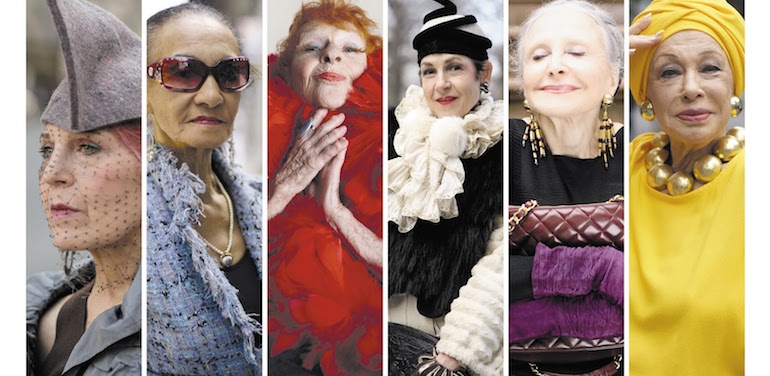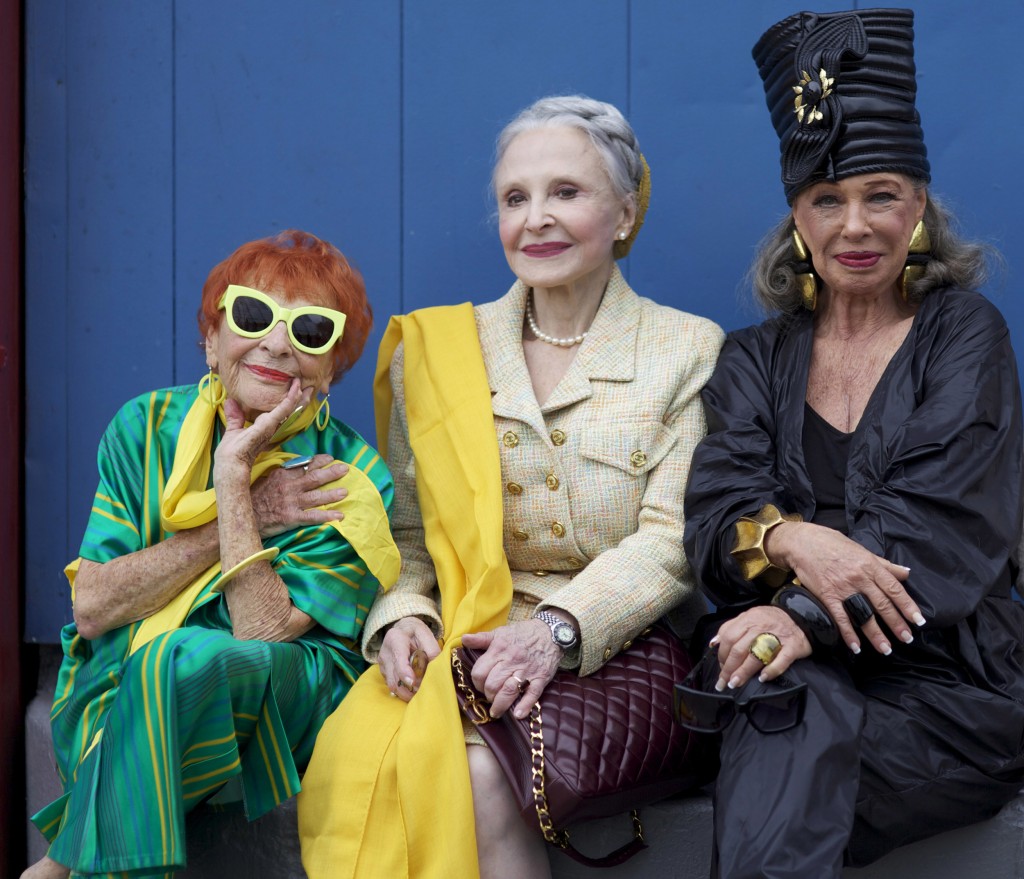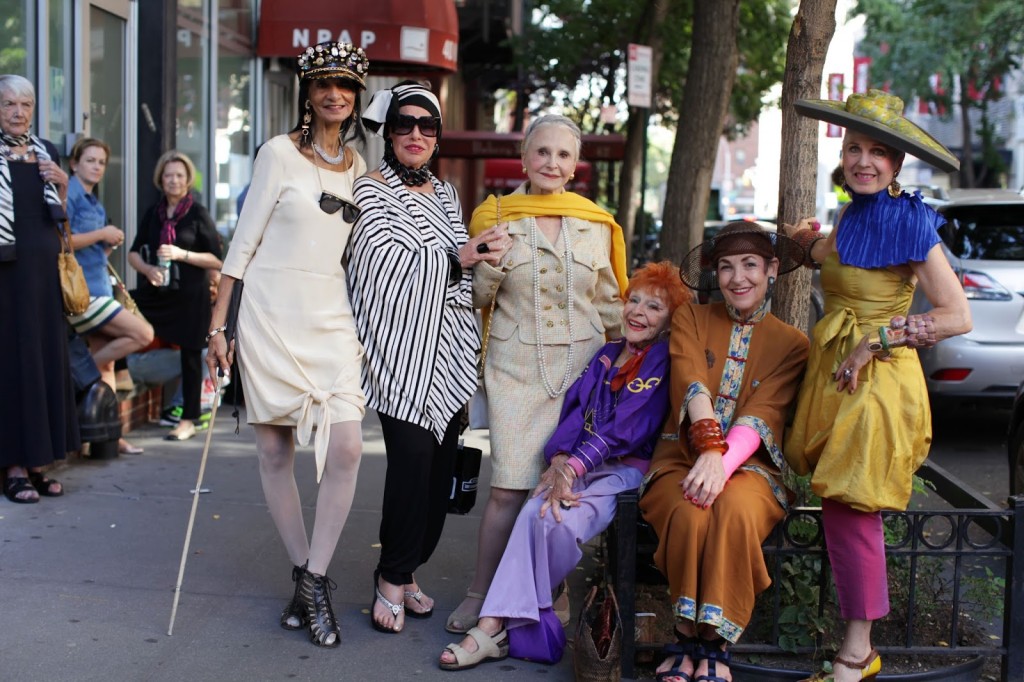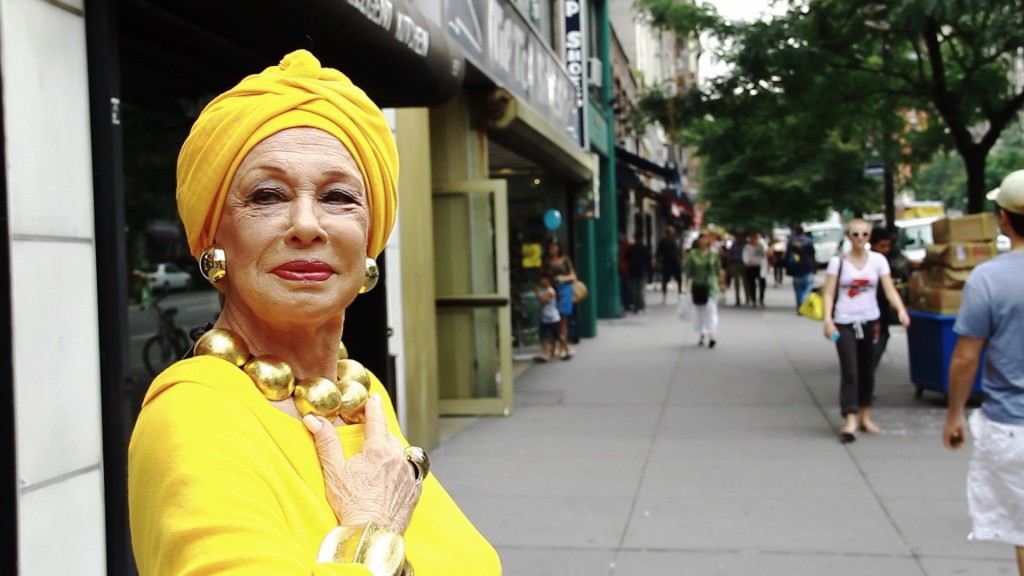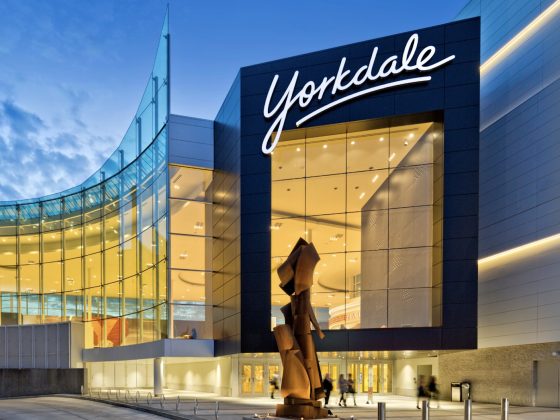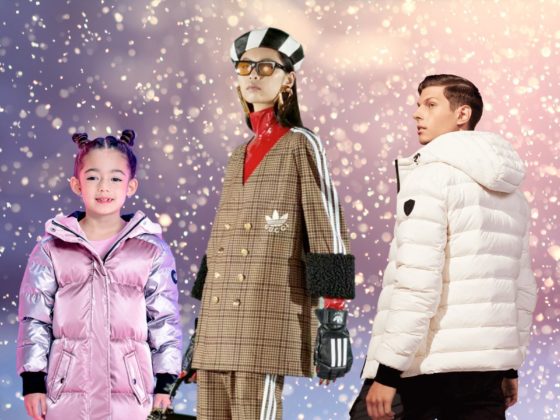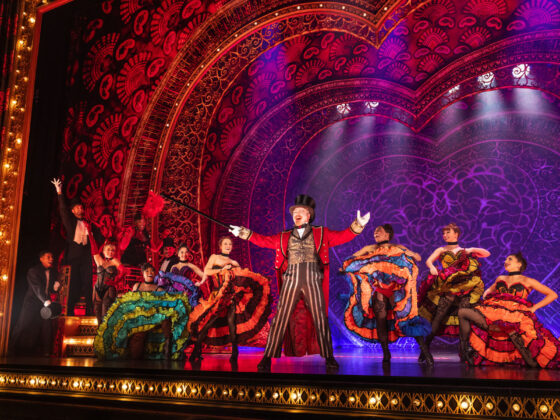Contrary to what many millennials might think and tweet, life does does not end at 30. Vv Magazine’s Vicki Hogarth got the chance to interview the creative team behind new film, Advanced Style, to find out how seven New York ladies keep it fabulous in their golden years…
“Sometimes I’m building an outfit for years… like, seven years, one outfit took,” says New Yorker Tziporah Salamon at the start of Advanced Style. “Because until I found the perfect earrings for that outfit, I didn’t wear the outfit. If the painting is not finished, I don’t take it out into the world. I do a portrait with clothing…”
At age 62, Tziporah is the youngest of the seven fashionistas featured in Advanced Style, a documentary about stylish New York women over 60, by photographer Ari Seth Cohen and filmmaker Lina Plioplyte. The film, inspired by Cohen’s blog of the same name, is already in theatres in Montreal and is premiering in Toronto and Vancouver this Friday, with an Edmonton release to follow on Boxing Day. Cohen started the blog as way to document the impressive street style of his adopted city’s most sartorially-savvy seniors. What started as a personal project, however, grew into a cultural phenomenon, thanks to a rapidly growing fan-base, which included some of the fashion world’s most influential figures. Soon, Marc Jacobs was using street style images from Advanced Style for his inspiration boards, and older people became a ground-breaking new demographic of intrigue for fashion houses like Lanvin, who began featuring them in campaigns. For a cultural climate so obsessed with youth, the shift occurring in the industry and on the streets was ground-breaking, and Advanced Style was playing a pivotal role in the revolution.
ADVERTISEMENT |
Advanced Style, the documentary, isn’t just a sneak-peek into the fabulous vintage-filled closets of Joyce, Lynn, Ilona, Deborah, Zelda, Tziporah and Jacquie; it’s a look into the many chapters of their full lives that have led them all to embrace the art of dressing and feeling beautiful no matter what age they happen to be. We spoke to friends and creators of Advanced Style, Cohen and Plioplyte, about the film, its influence on the beauty ideal and the fashion industry, and the style and life lessons that the seven featured women illuminate.
What initially gave you the idea to start the blog before the movie?
Ari Seth Cohen: I’ve had this affinity for older people since I was young and spent time with my grandmother. She always told me that if I wanted to do something creative, I should move to New York City. She had studied at Columbia but then moved to California where I was born. I was a caretaker to her during the last years of her life. When she passed away, I was planning on moving to New York City. I saw this film about a woman who was 94 named Mimi Weddell — this incredibly dressed, vital, wonderful woman. She’s from New York. The film is called Hats Off, and it’s a documentary. At the screening of the film, I met her and told her I was moving to New York and wanted to be friends with her. A month later, I moved to the city, became friends with her, was working at museum, and kept seeing all these incredibly-dressed, creative older people on the street. I was looking for a way to connect with the city and talk to older people. I just started taking their photos. I eventually realized that my perspective on aging was not the prevailing idea of getting older. Everything that I saw in media totally ignored older people or talked about the struggles and clinical aspects. A negative portrayal of aging was the dominant conversation. That was so different than my experience with Mimi and all these women I was meeting. I started the blog as a way to share these joyful, hopeful images about getting older.
ADVERTISEMENT |
Had you done a lot of photography before?
Cohen: No. I’d never taken a photo before. I was very fearful of doing something creative. I’ve always been a creative person, but I never thought that what I would do would be good enough. But I had such a passion for older people that I borrowed my roommate’s camera. I was managing a museum bookstore downtown and running out on my lunch breaks and taking photos. The project just grew to a point that it allowed me to do it full-time, but it wasn’t the expectation that I’d be able to do all this with my life.
In the early stages, what were the initial responses from people who you asked to photographed?
Cohen: The reactions were varied. A lot of people were very open, which is what allowed me to do this and then of course work with Lina to make the film. Because so many people tend to be ignored and are made to feel invisible, someone asking to take their photo allows them to have this opportunity to shine in that moment. A lot of people really responded to that. I think it’s also in my approach. I’m very respectful of these women, and I admire them. They’re my role models, and I think they feel that.
ADVERTISEMENT |
What influence have you seen Advanced Style have on the fashion industry with regards to changing the prevailing views on older people, particularly in campaigns?
Cohen: I did my campaign for Karen Walker with women 65 to 94. All these different beauty brands are using older actresses now in their campaigns – Jessica Lange for Marc Jacobs Beauty, and NARS just appointed Charlotte Rampling, and L’Oreal has chosen Helen Mirren as their new face. Even TV commercials are using older women – so they’re slowly awakening to the fact that there’s this demographic of people who’ve been ignored for so long.
Lina Plioplyte: The industry has definitely been affected, but it’s nice to see people being affected by the film as well because I think trend-making in the industry starts on the street because the designers look to the streets. I just came back from my home country, Lithuania, where the movie is showing in the theatres now. Seeing that even Eastern Europeans are feeling inspired – that 60-year-old women there want to play in their own closet – that’s so beautiful to me and it’s happening all over the place. We’ve been all over with this film – Canada, New Zealand, Amsterdam, South Africa – and we see people everywhere being inspired by it. In the movie, you can see that Lanvin steps forward looking for older models. And we’ve heard that Marc Jacobs, for one of his campaigns, used Advanced Style pictures for one of his inspiration boards. The whole industry is finally looking at who the real buyer is, and it’s not a 16 year old. It’s women 40 and over. It’s really nice to see a bigger variety in fashion and television. I think it’s a trend right now that age is in, but I think it’s a very good and healthy trend. We need a variety in press, TV, and fashion campaigns.
ADVERTISEMENT |
What kind of shifts have you noticed since the digital age took over? Have we become more accepting about aging?
Cohen: I wouldn’t have be able to do what I do without the internet. It allows for a lot more diversity in the imagery and visualization we have of beauty. Digital media has helped to reinforce the idea that aging can be a more positive thing.
How did you two meet to make the film?
ADVERTISEMENT |
Cohen: When I moved to New York, I moved to Williamsburg initially. I was working in a museum and Lina was working at the local coffee shop on my street. I’m an open person. I loved the way she put herself together. Even today, we’ll show up to a book signing or film screening and be dressed in similar outfits. We both have a love of mixing patterns. I responded to the way she put herself together and asked if she would be my friend. She told me she was an aspiring filmmaker, and I told her my idea for the blog. She went off and started working for fashion magazines making videos. I ran into her in a gallery a month later, and she told me she loved the women I was photographing and wondered if she could make some videos. We started out with small YouTube videos, and it grew from there. We started to get an incredible response from people about how these women were changing their views on aging, and we knew we had to make the film.
Plioplyte: He was wearing some kind of paisley or Hawaiian outfit, and I was wearing some kind of sparkle or leopard, so we recognized each other as someone who liked to play with clothes, and we became instant friends. Seeing the first pictures he took, I was immediately inspired, and asked if I could film the women. I went to their homes, filmed their closets, and put them on YouTube. I wasn’t dreaming of the movie! I was just interested in why these women were still playing with clothes and being creative and not listening to the rules of what you’re supposed to be wearing at that age. I was 25, and I saw lots of creative friends of mine growing out of their creative outfits and wearing boring clothes. Seeing someone who was 65, 80, or 100 and still having fun with clothes was the ultimate inspiration because I wanted to grow older and be playful with clothes. I wanted to know why they were still having fun. That’s the one question that started it all.
ADVERTISEMENT |
What inspired moving from YouTube videos and into making a film?
Plioplyte: After the first few YouTube clips went up, we had so many messages from people saying they were no longer afraid of getting older. This gave me inspiration to keep filming these ladies. When Ari put out the book Advanced Style in 2012, everything started gaining speed. The women started getting invited out, meeting each other, and becoming ambassadors for this movement. I was just filming all of it. When the best-dressed woman in town meets one of the other best-dressed women in town, interesting things happen. It was fun to observe them, and observe who becomes friends and who becomes a little bit like competitors. At that moment, I realized it was going to be a bigger project than a few-minute videos. I told Ari that we had to make the movie.
What life and style lessons can we take away from the women in the film?
ADVERTISEMENT |
Plioplyte: Each woman in the movie has a different approach to style. We have the extremely elegant Joyce who wears her signature pearls and a braid every day. Then we have a very bohemian and creative Deborah who has 30 pieces on at all times because she layers bangles, cardigans, shirts, belts, and hats and creates a different outfit every day playing with accessories. For her, dressing is a self-expressive act of creation. And then you have the countess of glamour, Lynn, who always says “the bigger, the better” and believes in the immediate impact clothing makes, therefore you’ll never see her in a tiny gold necklace – if she’s wearing a necklace, it’s huge! She believes in monochrome one-coloured outfits to make this impact because, as she says, “you only have one chance to make a first impression.” All of these women have one thing in common in their dressing in the style tips they provide, and it’s: dress for your body. All these women are experts in their own styles and knowing their own bodies. If harem pants are popular in fashion right now but don’t suit your body, don’t wear them. Lynn says, “Accentuate the positive, eliminate the negative.” It’s as simple as that. If you have amazing legs, show them. If you don’t have a nice belly, don’t show it. They don’t feel bad that their thighs are not perfect or they don’t have the most beautiful upper arms. You show what you’ve got that’s beautiful, and you disguise in a creative way what you don’t really want to show to the world. You just create a shape that’s flattering that suits the mood you woke up with.
Cohen: Overall, they have a similar message: be yourself. Don’t care what anyone else thinks. “Trend” is a dirty word. Don’t follow trends; follow your own instinct. Zelda made her own clothes and invented her own style, so she might encourage one to be comfortable in their own skin. One of Deborah’s things is try something backwards, upside-down, and any which way you can wear it. Turn a lampshade into a hat, and a hat into a lampshade. Joyce always says that elegance is of the utmost importance. If you wear black with a strand of pearl you’ll be the most stunning person in the room. Lynn always encourages people to wear hats and dress for the theatre of your life every day.
What are the overarching ways that taking on this project has changed your views of aging?
ADVERTISEMENT |
Cohen: It has changed my expectations. If I don’t do something in the next 10 years, maybe it will happen when I’m 80. It’s allowed me to be more present in the moment and realize that I don’t have to rush. All of these women have had so many lives in their own lifetimes, and it showed me that I don’t have to have all the answers now. Now, they’re even embarking on a new chapter of their lives where they’re going out and being ambassadors for aging in a creative way. I’ll just have to have someone like myself come along when I’m 80 years old.
Plioplyte: One of the most important effects of this film for myself is that I started this film when I was 25, and now I’m 31, and I’m less worried about aging now than I was when I began this project. These women inspire everyone to do what makes you happy without worrying what other people think. It’s much, much more than a style movie. It’s about being yourself and creating your own rules. These women gave me the guts and permission to be myself because they are worry-free. They know that dressing in a creative way makes them happier. Clothing has a strong power to change our mood. We can all wear black, grey, and boring clothes, or we can illuminate our day with sparkle, texture, and creativity. It really alters the way we feel. It’s important to wrap yourself in something that makes you feel fun, luxurious, or more playful. It seeps into how you lead your life.
Will you be watching Advanced Style? Let Vv Magazine know your thoughts on “Advanced Style: Inside the Art of Aging Beautifully” in the comments below or tweet us @ViewTheVibe.
ADVERTISEMENT |


